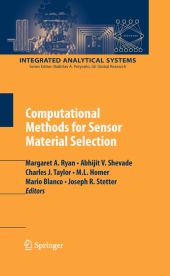 Neuerscheinungen 2014Stand: 2020-02-01 |
Schnellsuche
ISBN/Stichwort/Autor
|
Herderstraße 10
10625 Berlin
Tel.: 030 315 714 16
Fax 030 315 714 14
info@buchspektrum.de |

Mario Blanco, M. L. Homer, Margaret A. Ryan, Abhijit V. Shevade, Joseph R. Stetter, Charles J. Taylor
(Beteiligte)
Computational Methods for Sensor Material Selection
Herausgegeben von Ryan, Margaret A.; Shevade, Abhijit V.; Taylor, Charles J.; Homer, M. L.; Blanco, Mario
2010. 2014. xv, 319 S. 21 Tabellen. 235 mm
Verlag/Jahr: SPRINGER, BERLIN; SPRINGER NEW YORK; SPRINGER 2014
ISBN: 1-489-98416-X (148998416X)
Neue ISBN: 978-1-489-98416-6 (9781489984166)
Preis und Lieferzeit: Bitte klicken
This volume provides an in-depth analysis of the components and computational methods required in sensor material selection. Readers will find a discussion of applications that include process control, medical diagnosis and environmental monitoring.
Chemical vapor sensing arrays have grown in popularity over the past two decades, finding applications for tasks such as process control, environmental monitoring, and medical diagnosis. This is the first in-depth analysis of the process of choosing materials and components for these "electronic noses", with special emphasis on computational methods. For a view of component selection with an experimental perspective, readers may refer to the complementary volume of Integrated Microanalytical Systems entitled "Combinatorial Methodologies for Sensor Materials."
1. INTRODUCTION: Experimental Methods In Chemical Sensor And Sensor Array Evaluation And Development
2. Electromechanical and chemical sensing at the nanoscale: DFT and transport modeling
3. Quantum Mechanics and First-Principles Molecular Dynamics Selection of Polymer Sensing Materials
4. Prediction of quartz crystal microbalance gas sensor responses using Grand Canonical Monte Carlo method
5.Computer-Aided Design of Organic Host Architectures for Selective Chemosensors
6. First Principles Molecular Modeling of Sensing Material Selection for Hybrid Biomimetic Nano-Sensors
7. Development of new sensing materials using combinatorial and high-throughput experimentation
8. Chemical Sensor Array Response Modeling Using Quantitative Structure-Activity Relationships (QSAR) Technique
9. Design and Information Content of Arrays of Sorption-based Vapor Sensors using Solubility Interactions and Linear Solvation Energy Relationships
10. A Statistical Approach to Materials Evaluation and Selection for Chemical Sensor Arrays
11. Statistical Methods for Selecting the Components of a Sensing Array
12.Hybrid Arrays for Chemical Sensing
13. Future directions
From the reviews:
"The book is written in a comprehensible manner. Each chapter contains descriptive examples. After a short introduction, the book gives very detailed information about scientific issues in each topic. Besides quantum mechanical principles, statistical approaches are covered as well. Therefore, all important topics for selecting sensing materials for chemical vapor sensing are covered. Owing to this excellent collection, the book is recommended for all scientists working on chemical vapor sensing." (Felix Kolarov, Analytical and Bioanalytical Chemistry, Vol. 397, May, 2010)


